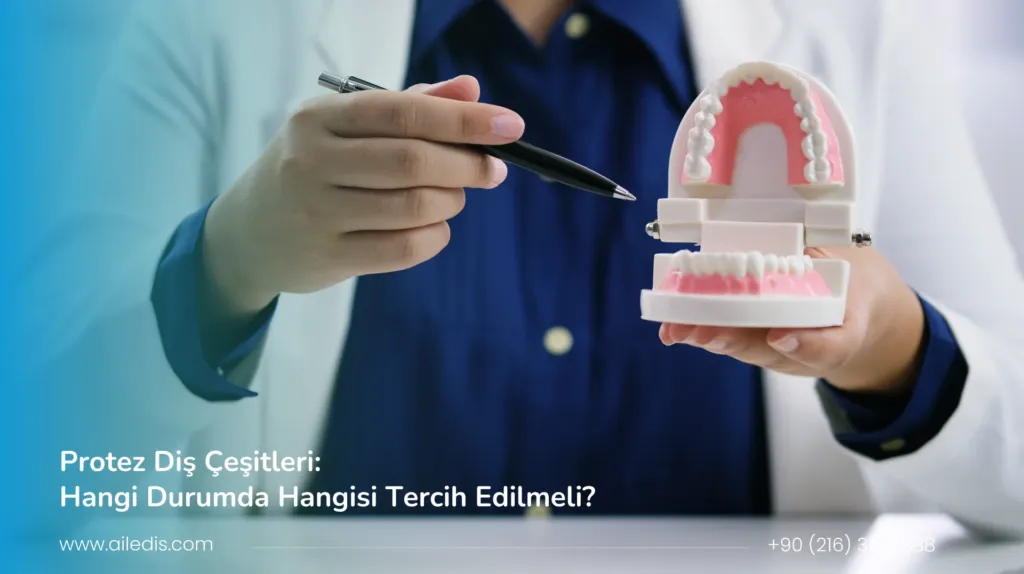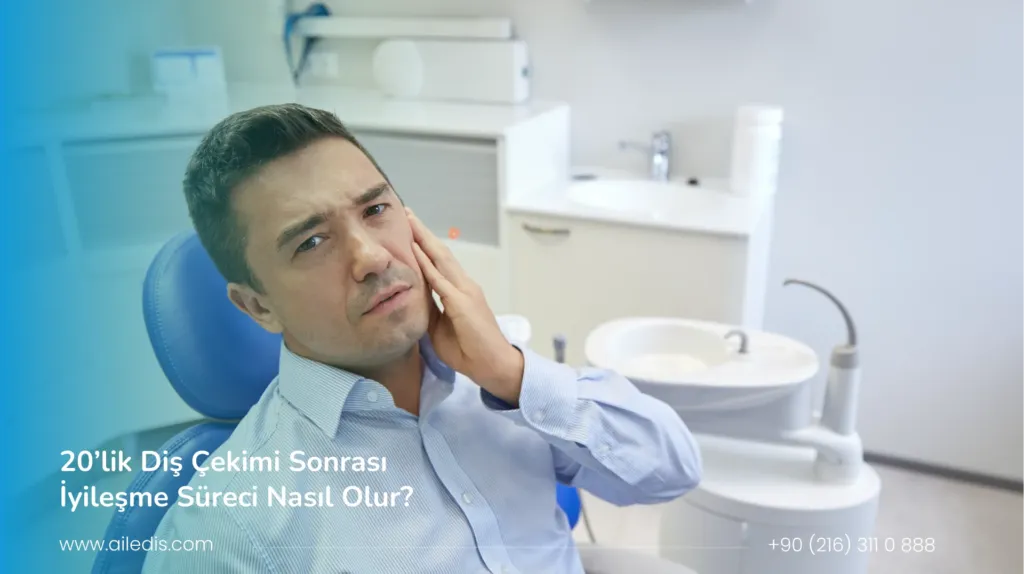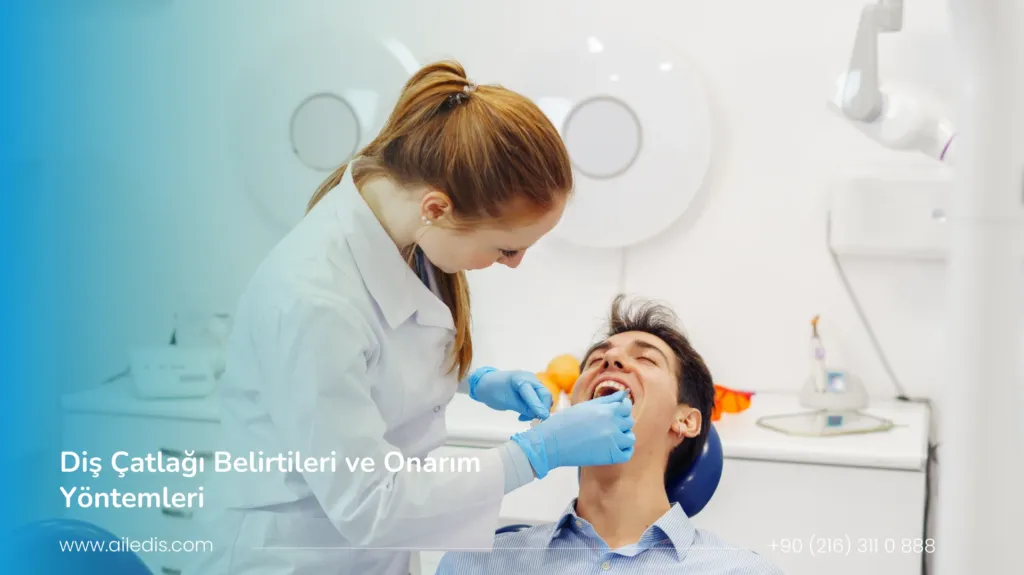Dental health is of great importance in terms of general health and quality of life. However, sometimes small problems can turn into serious problems when neglected.. Tooth Cracks one of these problems.
Many people continue to live without noticing the cracks in their teeth, but this can cause pain, tenderness and even tooth loss over time.
PRIVATE FAMILY DENTAL CLINIC, provides service with advanced technology devices and experienced physicians in the early diagnosis and repair of tooth cracks.
A crack that is noticed in the early period can be easily repaired with appropriate treatment; This ensures both the relief of pain and the preservation of the structural integrity of the tooth.
In this article, Symptoms of tooth crack, , Reasons for occurrence and Effective treatment methods You will find comprehensive information about it. He will also learn the protective measures that can be applied on cracked teeth, Family Dental Clinic You will discover how to achieve a healthy smile with their professional approach.
What is a tooth crack and how does it occur?
Tooth cracks are slits or fractures that occur in the enamel or dentin layer. This situation usually occurs as a result of excessive force application, stress or dental trauma during chewing.
It may manifest itself with symptoms such as heat-cold sensitivity and pain over time. Tooth cracks can sometimes be invisible; For this reason, regular dental check-ups are of great importance. Early diagnosis helps prevent more serious problems.
What causes a tooth crack?
There are many causes of tooth crack. Generally, excessive chewing of hard foods weakens the structure of the tooth and leads to cracking. In addition, habits such as bruxism (tooth grinding) in the mouth also cause stress in the teeth, triggering the formation of cracks.
Another factor is aging. Thinning of tooth enamel and naturally occurring abrasions contribute to the development of cracks. Hot-cold sensitivity can also make this situation worse.
Types of tooth cracks (mine, root and vertical cracks)
Tooth cracks are divided into several types. Enamel cracks are usually seen on the surface of the tooth and can create aesthetic concerns. These cracks can also cause extreme heat-cold sensitivity.
Root cracks occur in the root of the tooth and are usually a symptom of a deeper problem. Vertical cracks extend along the length of the tooth and can lead to pain. Each type offers different treatment requirements.
Risk factors in cracked tooth formation
Various risk factors can be effective in the formation of tooth cracks. Intense stress, teeth grinding (bruxism) and bad habits are some of them. In addition, the structure of the teeth may weaken as we age.
Consuming extremely hot or cold foods can also cause cracks in the teeth. When the enamel is thinned, the risk of cracking increases. It is possible to minimize these risks with regular dentist checks.
What are the symptoms of a tooth crack?
Symptoms of tooth crack usually begin with pain and discomfort. Cracked teeth can create sensitivity when consumed hot or cold foods. In addition, pain may be felt when pressure is applied during chewing.
Changes in the appearance of the tooth may occur; coloring or small cracks in the surface can be observed. These situations are important signs that should be evaluated by a dentist.
How to detect tooth crack pain?
Tooth crack pain is usually felt in a sharp or throbbing way. Pain may increase during chewing or when consuming hot and cold foods. These symptoms may indicate damage to the internal structure of the tooth.
At the same time, a feeling of tenderness and discomfort in the tooth can be seen. It is important to contact your dentist without wasting time to understand the severity of the situation. With the right diagnosis and treatment, the problem can be fixed quickly.
Hot-cold sensitivity and pressure pain
Tooth cracks can cause hypersensitivity to hot and cold foods. This happens by stimulating the nerve endings caused by the crack in the tooth. Pain that is felt suddenly, especially when drinking hot tea or cold water, is common.
In addition, the pressure applied to the tooth can also cause a painful pain. When the tooth is pressed, the crack will expand and in this case the discomfort increases. If such symptoms are observed, it is important to immediately consult a dentist.
Changes in the appearance of the tooth and coloration
Tooth cracks can lead to significant changes in the appearance of the tooth. These cracks create sensitivity on the enamel surface and may not be aesthetically pleasing. Fine lines or deep crevices can be observed on the teeth.
Coloring is also a common occurrence. Cracks can cause bacteria to accumulate in the tooth, which leads to discoloration. Dark spots or yellowing may indicate deterioration of dental health.
How to diagnose a tooth crack?
Diagnosis of tooth cracks is made as a result of detailed examinations with both clinical and radiographic methods.. PRIVATE FAMILY DENTAL CLINIC Physicians begin to evaluate the patient’s complaints such as pain, tenderness or discomfort during the bite.
Thanks to the radiographs, it is determined whether the depth, direction and root level of the crack reach the crack. In this process, factors such as caries, wear or clenching are also taken into account. Correct diagnosis is of great importance in terms of determining the appropriate treatment.
Radiographic and clinical examination methods
Diagnosing tooth cracks radiographic examinations plays a big role. The dentist detects how far the crack has progressed to the root of the tooth with X-ray images. This method is very effective in detecting invisible microcracks.
During the clinical examination, the surface of the tooth, the surrounding tissues and the patient’s pain points are evaluated in detail. The physician can observe the crack line more clearly by using special light and magnifying systems.
| Review method | Purpose of | Application feature |
| Radiographic examination (X-ray) | Determines the depth and spread of the crack. | Detects invisible cracks. |
| clinical examination | Evaluates visible symptoms. | It is supported by intraoral light and sensitivity tests. |
| Sensitivity tests | It measures the effect of crack on the nerve. | Cold or pressure tests are applied. |
Using these methods together ensures that the most accurate diagnosis is reached.
The process of determining the depth of the crack
The depth of the tooth crack directly affects the treatment plan. Superficial cracks can usually be repaired by filling or coating, while deep cracks can reach the nerve of the tooth.
The progression level of the crack is determined by X-ray and sensitivity tests. If necessary, detailed analysis is performed using advanced imaging techniques. In this way, both the protection of the tooth and a long-term solution plan can be prepared.
not to mix the cracked tooth with caries
Tooth cracks can often be confused with caries because both cause pain and tenderness. But while bruises are usually of bacterial origin, the cracked tooth is a more mechanical problem.
Pain in the cracked tooth is felt suddenly and sharply, especially in biting or hot-cold contacts. In caries, the pain is usually more persistent and dull. Therefore, professional examination is essential for distinctive diagnosis.
Tooth Crack Treatment Methods
The approach in the treatment of tooth cracks varies according to the depth of the crack and the position in the tooth. The aim is to both eliminate pain and protect the structure of the tooth.
The most commonly used methods are:
- Composite Filling Applications: It is an aesthetic and fast solution for superficial cracks.
- Root canal treatment: It cleans the infected tissues in the cracks that reach the nerve.
- Porcelain veneer or crown: It strengthens the tooth, gives both aesthetics and durability.
- Tooth extraction and implant: It is applied to restore function in unrecoverable teeth.
PRIVATE FAMILY DENTAL CLINIC, creates personalized treatment plans in order to determine the most appropriate method for each case.
Can the cracked tooth be repaired with filling?
If the crack in the tooth is at the superficial level, it can be repaired by composite filling method. This process both improves the aesthetic appearance and increases the durability of the tooth by closing the crack line.
However, only filling may not be enough in cracks advanced up to the root or nerve region. In this case, root canal treatment or coating procedures are required. Physician examination is the most accurate way to determine which method is suitable.
Does root canal treatment save tooth cracks?
root-stockIt is an effective method for the recovery of the tooth in deep cracks. In this process, the infected nerve tissues are cleaned and the duct system is filled and the tooth is closed. Thus, the risk of infection is eliminated.
However, not all cracked teeth can be saved by root canal treatment. If the crack has protruded beyond the root or the structure of the tooth is severely weakened, different treatment options should be considered. Regular dentist checks are important in early detection of these risks.
Porcelain veneer or crown applications in tooth crack
The porcelain coating offers both an aesthetic and protective solution with a thin layer applied to the surface of the tooth. It is ideal for obtaining a natural appearance, especially on the front teeth.
In larger damages, Crown (tooth crown) applications are preferred. Crown eliminates the risk of breakage by covering the entire tooth. It is a long-lasting solution both aesthetically and functionally.
Tooth extraction and implant alternatives if necessary
In some cases, the tooth crack is so advanced that it is not possible to save the tooth. In this case, in order to prevent the spread of infection tooth extraction done.
After tooth extraction Implant treatmentIt offers a permanent solution that mimics the natural tooth root. Implants are both aesthetically pleasing and functionally powerful.
Front tooth crack and aesthetic repair options
Anterior tooth cracks can cause aesthetic discomfort. There are many options for repairing such cracks. Composite fillings offer a quick solution by preserving the natural appearance of the tooth.
Lamina applications can also be an ideal choice in terms of aesthetics. Thin porcelain layers close the crack, providing a smoother appearance. It is important to consult with your specialist to ensure color harmony; In this way, the integrity of your smile is preserved.
Visual correction with composite padding
Composite filling is a frequently preferred method for aesthetic correction of cracked teeth. This process, which is applied using special materials compatible with the natural color of the tooth, eliminates appearance disorders.
The dentist chooses the appropriate composite color according to the depth and location of the crack. In this way, the filling both increases the functionality and provides an aesthetic result by closing the crack in the tooth.
Lamina (Leaf Porcelain) Application
Lamina application is thin porcelain layers used to provide an aesthetically perfect appearance in the front teeth. These laminas glued to the surface of the tooth imitate natural tooth color and transparency, thereby beautifying your smile.
This method helps to hide problems such as cracks or deformations, while also improving the shape of the teeth. Lamina applications are minimally invasive and are usually completed in a short time.
The importance of color harmony in anterior tooth cracks
Anterior tooth cracks are of great aesthetic importance. Teeth are the most striking elements of a smile. Ensuring color harmony increases one’s self-confidence. The appearance of cracks may be evident after treatment.
Dentists choose the color tone according to the patient’s natural tooth color. In this way, after the repair process, the teeth both look healthier and get a natural appearance. Choosing the right color during aesthetic renovations plays a critical role.
Cracked or toothy? How is the difference understood?
Tooth cracks and caries may show similar symptoms. However, it is possible to distinguish according to the type of pain. While a sudden pain in the tooth crack is usually felt, cavities create a more continuous and throbbing discomfort.
Also, it can be difficult to make a definitive diagnosis without a dentist examination. Your dentist will make the necessary tests clear and determine the appropriate treatment method. Therefore, regular checks are very important.
Distinguishing methods by type of pain
It is important to pay attention to the type of pain in order to understand the difference between tooth crack and caries. Pain in a tooth crack usually occurs as a response to a stimulus and can start suddenly. This type of pain can be triggered by hot or cold foods.
On the other hand, the pain in the bruises is constant and often felt more intensely. Also, the discomfort becomes violent as the decay progresses. These differences are of great importance for accurate diagnosis.
The importance of not making a decision without a dentist control
Dental health often has a more complex structure than it seems. To distinguish between cracks or cavities in the teeth, it is necessary to get expert opinion. Deciding on your own can worsen the situation.
A dentist can make the correct diagnosis by making the necessary examinations. In this way, the treatment process is determined and possible complications are prevented. Interventions without expert evaluation can lead to permanent damage.
Cracked tooth treatment and follow-up process in Private Family Tooth
Cracked dental treatment in Private Family Tooth begins with a specialist dentist evaluation. As a first step, the condition of the tooth is examined in detail. The depth and type of crack are determined.
The most appropriate treatment method is determined by creating a personalized repair plan. Post-treatment control appointments are arranged and the patient’s recovery process is closely monitored. Thus, possible problems are prevented and a healthy mouth structure is maintained.
Specialist Dentist Review
Expert dentist vision is very important for the accurate evaluation of tooth cracks. Your dentist performs a detailed examination, taking into account symptoms such as pain and tenderness.
It can determine the depth of the crack with radiographic examinations. In this process, the most appropriate treatment plan is created, taking into account the general condition of your dental health. Expert opinion plays a critical role in preventing future problems.
Creating a personalized repair plan
In the treatment of tooth cracks, each individual’s tooth structure and needs are different. Therefore, creating a personalized repair plan is critical. The specialist dentist determines the most appropriate treatment method, taking into account the general health status of the patient, age and lifestyle.
During the planning process, the patient’s pain level and the crack depth of the tooth are also taken into account. Thus, both functional and aesthetically satisfactory results are obtained by providing the most effective solution.
Post-treatment control and preventive recommendations
Regular controls after tooth crack treatment are of great importance. Your dentist will track your recovery process and determine the steps needed to prevent possible complications.. Condition of the treated tooth It is necessary to get information about it and to check the applied repair.
Protective recommendations include brushing your teeth regularly, using dental floss and eating healthy. Otherwise, the risk of new cracks may increase. You can also protect your dental health by staying away from acidic and hard foods. Acting in line with expert opinions will always give the best results.



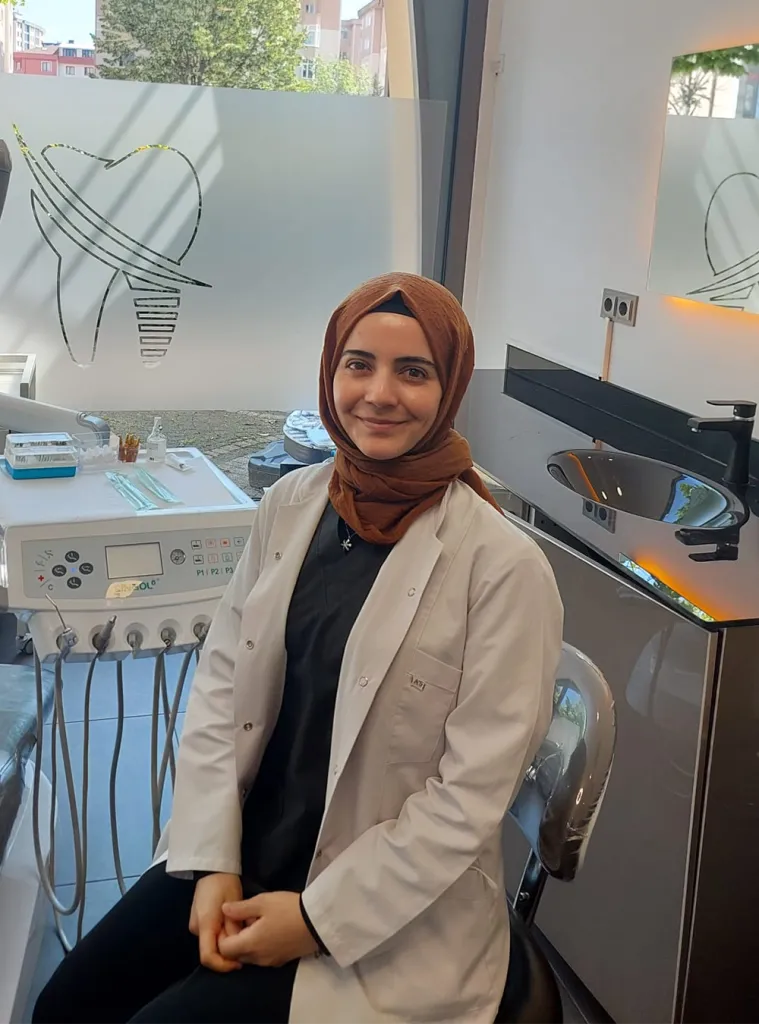
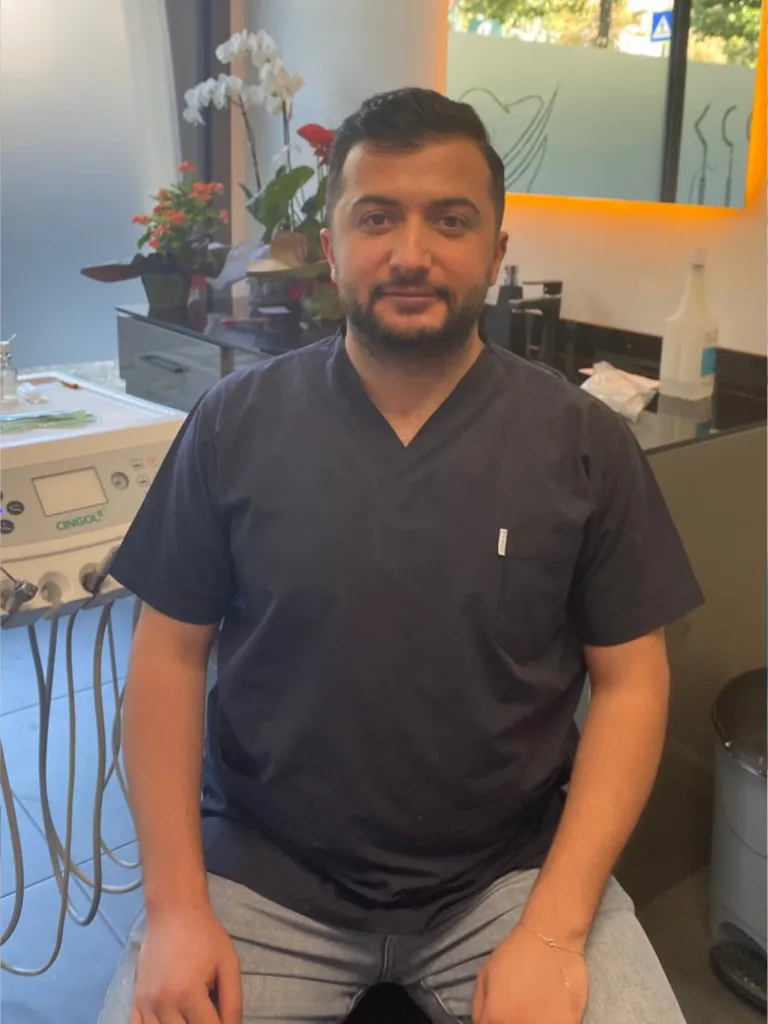


Frequently asked questions
How can you tell if a tooth is cracked?
If you experience pain while chewing, sensitivity to hot or cold, or discomfort in a specific area of your tooth, it may be cracked. Sometimes it cannot be seen with the naked eye; diagnosis is usually made using an X-ray or magnification.
Does a cracked tooth hurt?
Yes, a sharp pain may be felt, especially when two parts of the tooth move during chewing. Additionally, short-term sensitivity to cold drinks is also common.
Can a cracked tooth be extracted?
Not every cracked tooth needs to be extracted. If the crack has not progressed to the root of the tooth, it can be saved with a filling, crown, or root canal treatment. However, extraction may be necessary for deep cracks.
Can a cracked tooth be treated with a filling?
Yes, if the crack is small, it can be repaired with composite filling. For wider cracks, veneers or E-Max restorations are preferred.
Is a front tooth crack permanent?
Cracks do not heal on their own, but a permanent solution can be achieved with the right treatment. For aesthetic reasons, porcelain or E-Max veneers are usually applied to the front teeth.
What causes a cracked tooth?
Biting hard foods, clenching your teeth, trauma, or pressure differences in old fillings can cause cracks.
Does a cracked tooth get bigger over time?
Yes, if left untreated, the crack will deepen over time and may lead to the tooth breaking. Early intervention is very important.
Diş çatlağı röntgende çıkar mı?
Some small cracks may not be visible on an X-ray. In this case, the dentist will make a diagnosis using special light, magnification, or thermal tests.



